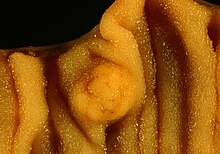Carcinoid
| Classification according to ICD-10 | |
|---|---|
| E34.0 | Carcinoid Syndrome |
| ICD-10 online (WHO version 2019) | |
In medicine, the outdated, not always uniformly used term carcinoid refers to a certain type of neuroendocrine tumor (NET). The typical symptoms ( flushing , diarrhea and bronchospasm ) that occur in the context of carcinoids are also referred to in their entirety as carcinoid syndrome (synonyms: Steiner-Voerner syndrome or Cassidy-Scholte syndrome ). Most often, carcinoid syndrome is caused by an excessive secretion of serotonin . A potentially life-threatening form of carcinoid syndrome is called a carcinoid crisis .
Systematics
The term "carcinoid" was coined in 1907 by the pathologist Siegfried Oberndorfer . Carcinoids are tumors of the so-called neuroendocrine system . They are characterized by their mostly low malignancy and, due to the relatively high degree of differentiation of the tumor cells, characterized by slow growth and a good prognosis. But they can also occur in a malignant (malignant) variant.
The carcinoid is found on the thymus , bronchial system , stomach , duodenum , jejunum , ileum , appendix vermiformis and rectum . 80 percent of tumors affect the terminal ileum and appendix.
The term carcinoid is rarely used. The terms "diffuse neuroendocrine neoplasias" or, according to the World Health Organization, "neuroendocrine tumors" (NET) are preferred . Special forms of NET are the endocrine-disrupting VIPomas, gastrinomas, insulinomas and pheochromocytomas .
pathology
Carcinoids are submucosal tumors that can develop anywhere where neuroendocrine cells are present. In the course of tumor progression, the tumors penetrate the tunica muscularis and in the further course, first lymphogenic and later also hematogenic metastases develop . The metastases of the carcinoid are often larger than the primary tumor .
In contrast to most neoplasms, the symptoms do not arise from the displacement of healthy tissue or the consuming effect, but primarily from the production of tissue hormones : kallikrein and others, but above all serotonin .
Symptoms
The carcinoid syndrome is characterized by the triad diarrhea (diarrhea), flush (blushing) and Hedinger syndrome (cardiac manifestation of the carcinoid syndrome).
Persistent diarrhea is often the first sign of the disease. “ Flush symptoms ” (also known as “ flush syndrome ”) are a sudden blue-red discoloration of the face, neck and possibly the upper body. The flush is relevant for localization diagnosis insofar as it suggests an already metastatic (into the liver; often also palpable ) or primarily extra-intestinal location of the carcinoid. In tumors only intestinally (within the gastrointestinal tract), the serotonin is broken down by the liver (see also portal vein circulation) and does not lead to flushing . In the late stage, the syndrome is characterized by endocardial fibrosis of the right heart, which can lead to tricuspid regurgitation and pulmonary stenosis (both forms of heart valve damage). Other long-term consequences can include pellagra-like dermatoses , tachycardias (high heart rate), behavioral changes, Cushing's symptoms (due to ectopic ACTH formation), and possibly asthma attacks .
A carcinoid crisis can be triggered by (also emotional) stress, surgery (surgical manipulation of the tumor), during anesthesia, drop in blood pressure, hypothermia and hypercapnia.
diagnosis
Elevated chromogranin A values in the serum provide a first indication . The evidence of increased serotonin levels in serum or of 5-hydroxyindolylacetic acid (breakdown product of serotonin) in urine is usually indicative. However, normal serotonin levels or negative evidence of 5-HIES do not rule out a tumor. The diagnosis is often made late because carcinoids / neuroendocrine tumors often do not cause symptoms for a long time. Unspecific complaints that can intermittently, such as diarrhea, constipation, abdominal pain and flushing, are often misinterpreted as irritable bowel syndrome . The tumors are therefore often advanced at the time of diagnosis and, despite their sometimes small size, may have metastasized.
Primary tumor and metastases are detected using sonography , computed tomography (CT), angiography, or endoscopy . It is also possible octreotide - scintigraphy because the carcinoid have these receptors. With newer nuclear medicine detection methods, especially with PET (mostly coupled with a CT), intensive attempts are currently being made to detect the often very small tumor foci at the earliest possible stage.
therapy
Primary therapy is the surgical removal of the primary tumor and, if possible, individual metastases. Treatment with a somatostatin analogue (octreotide) can improve the symptoms by inhibiting hormone secretion and is likely to have a cytostatic effect on the tumor. Therapies with alpha interferon and serotonin antagonists ( methysergide ) have also proven to be effective.
literature
- Scott N. Pinchot, Kyle Holen, Rebecca S. Sippel, Herbert Chen: Carcinoid Tumors. The Oncologist, December 2008 ( full text ), doi : 10.1634 / theoncologist.2008-0207
- T. Ito, L. Lee, RT Jensen: Carcinoid Syndrome: recent advances, current status and controversies. In: Curr Opin Endocrinol Diabetes Obes. Volume 25, 2018, pp. 22-35.
- David Binas, A.-K. Schubert, D. Wiese, H. Wulf, T. Wiesmann: Perioperative management in patients with carcinoid syndrome / neuroendocrine neoplasia. In: Anaesthesiology & Intensive Care Medicine. Volume 61, 2020, pp. 16-24.
Web links
- Carcinoid Cancer Foundation (English)
- Neurorendocrine Tumors Network (NeT) e. V.
- German registry for neuroendocrine gastrointestinal tumors
Individual evidence
- ↑ M. Grand, A. Thielken et al. a .: Pathology of neuroendocrine neoplasms. Adapted classification, grading and TNM classification 2017: "Nomen est omen?" In: Therapeutische Umschau. 2017, pp. 190–196.
- ^ Siegfried Oberndorfer: Carcinoid tumors of the small intestine. In: Frankfurter Zeitschrift für Pathologie. 1907, pp. 426-429.
- ↑ Herold, Gerd: Internal Medicine - A lecture-oriented presentation . Herold Verlag, Cologne 2009. p. 481
- ↑ D. Binas et al.: Perioperative management in patients with carcinoid syndrome / neuroendocrine neoplasia. 2020, pp. 16 and 19 f.
- ↑ KJ Woodside et al.: Current management of gastrointestinal carcinoid tumors. In: Journal of Gastrointestinal Surgery. 8, 2004, pp. 742-756.

